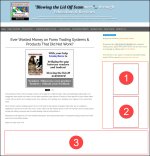- Home
- Money Management Tips
- Position sizing methods: an important aspect of money management
Position sizing methods: an important aspect of money management
by John Robinson
(www.forextraders.com)
Give no consideration to position sizes, enter arbitrary orders with random sizing, and in the best case scenario your account will stagnate around the break-even point. Successful traders ensure that trade sizing is proportionate to the risk assumed, and they employ different strategies devised by market professionals for the same purpose. Naturally, the subject is a lot more complicated than what we can examine in this article, but we believe that the brief introduction can be useful to beginners of forex trading, and even some intermediate traders.
The volatility model: In this model, each position is sized according to the volatility of the underlying currency pair. When volatility is high, position size is reduced, conversely, if volatility is low, greater positions are possible. Volatility can be determined according to market statistics, by using VIX options for the stock market, by the use of volatility options in the forex market, or the trader can use a method which he himself creates. In example, if future volatility, as indicated by the VIX or currency options is going up, we gradually reduce the size of our positions and employ lower leverage. The purpose is to maintain a constant level of risk by allowing greater swings when our exposure is small, and maintaining a smaller exposure to market fluctuations when they are sizable. It is well-known that large hedge-funds and professional traders at banks also use the volatility model in managing their risk, especially in uncertain market conditions. For example, when in autumn in 2009 Lehman Brothers went bankrupt, carry trades, the JPY pairs, and the EURUSD pair suffered greatly in the ensuing de-leveraging. As large speculators reduced their leverage in response to volatility, they had to cut position sizes which naturally resulted in large downward spikes in all the previously popular pairs.
Risk model: In this model positions are sized in such a way that the assumed risk is constant. Risk is determined based on the distance of the stop-loss order from the entry price. So, for instance, if we open a $10000 position for which the stop-loss order is 10 pips away from the open price, we’ll enter a $20000 position for a position where the stop (and therefore the maximum risk) is just 5 pips. Conversely, if the stop-loss order is at 20 pips from the open price, our maximum trade size will be $5000. In other words, the product of the stop-loss distance, and the size of the trade remains constant. For example, when risking $10000, with a stop ten pips away from the entry price, the product is 10000*100=100000. If we increase trade size to $20000, following the constant risk model, where should our stop-loss order be? 100000 = 20000 * (stop-loss distance), and so, the distance needs to be five pips in order keep risk constant. When doubling position size, we need to halve the trigger distance of the stop-loss order. Placing all this into a formula, we get
R = S * D = constant
where
R = risk (the total amount that might be lost in an adverse trade)
S = trade size (the size of the position)
D = distance of the stop loss point (the distance between the opening price, and the stop-loss point in pips)
This method is useful, but it may not always capture the risks inherent in specific market conditions, such as that of a sudden widening of spreads in highly volatile market. Stops cannot always provide maximal protection against losses.
It is possible to combine the above two approaches in order to manage risk and volatility.
Leverage model: In this model trader adheres to a constant leverage ratio for each position opened. Not an exceptionally profitable or prudent strategy, but in cases where all trades are in the same currency, for example, it can be appropriate and beneficial. This method is more suitable for beginners who do not yet possess to the discipline to adjust monitor a trade calmly, and instead focus on grasping the basics, while applying a minimal amount of leverage.
In addition to these models, mathematical formula such as the z-score, and the Kelly criterion have been used for traders for managing position sizes. Although these and the other mathematical tools can be very helpful for formulating our strategies and plans, even simple discipline in trading can greatly amplify the fruits of our analytical efforts. Searching through forex broker lists may help you find some competent and honest firms for trading, but the best way of ensuring the safety of your account is carefully controlling risk through a disciplined approach to all aspects of trading, including, of course, position sizes. Study, practice, and experiment, and very soon you’ll find that the rewards of your trading justify the time and energy invested to perfecting your skills richly.
Have you ever thought about how you can boost your trading performance and determine trade size based on the number of winning and losing streaks your system generates?
Find out by reading the article entitled "Using the Z score to determine trade size & boost performance". Read more on this link www.forextraders.com/forex-money-management/using-the-z-score-to-determine-trade-size.html
Article contributed by John Robinson, editor for www.forextraders.com
Forextraders.com website contains many other educational and informative trading articles.





